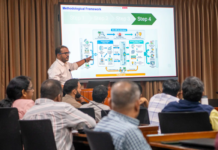
IRIS Fillet Inspection secures food quality
Today, good food quality is on every consumer’s mind. Everybody wants to know exactly what’s on their plate and that it is of high quality. As the global leader in food processing solutions, Marel is investing heavily in securing food quality. IRIS Fillet Inspection is the latest addition to Marel’s food quality program for poultry processors. This IRIS FI camera solution is an excellent tool for quality assurance of chicken fillets.
Quality control is an essential aspect in today’s poultry processing plants. Instead of incorporating human bias into quality inspection, it makes more sense to assign this job to an intelligent automated system. Marel’s IRIS FI (Fillet Inspection) camera offers such a visual quality assessment. Because of its ability to detect defects such as bruises, fat and skin, IRIS FI takes the lead in supplying highest quality poultry meat.
Trimming
In a processing plant, a typical fillet line will feature a deboning system, a trimming station and a bone scanner. Additionally, IRIS FI offers the option to secure the visual quality. Installed after the trimming station, it can check in real-time whether the trimmed fillets, that are on the conveyor belt at that moment, meet the quality requirements of the customers. If trimming is done too intensely, too much valuable meat weight will be downgraded. Too mild trimming can lead to customer complaints and a lower order intake.
Wat does IRIS Fillet Inspection see?
For fillet inspection, it is easy to set IRIS FI’s allowed tolerance threshold of individual bruises, total bruise area, fat defects and total fat area. Deviant fillet shapes can also be taken into account. Among the fat defects, residual skin –not removed by a skinner– is also detected. Detected bruises can be subcutaneous bleedings or blood clots –visible as sharp, red dots that can simply be wiped off. As a result of inferior wing separation, the wing pit is notably a critical spot where several defects may occur, such as blood spots or remaining tendons. On the other hand, too enthusiastic trimming in this area will result in odd fillet shapes and too much good meat spoiled.
Distribution options
IRIS Fillet Inspection can be combined with Innova distribution software and a fillet distribution system, allowing to filter out the products that don’t meet the criteria. Trimmers could miss a slice of fat or cut off too much, leaving an odd-shaped fillet. Such products are unwanted in a retail tray and should be directed to a different process stream.
The camera and the software cooperate in assigning a certain quality to the fillets and this quality information can be used for decision-making for downstream distribution.
In every situation, IRIS Fillet Inspection is the perfect tool to select poultry fillets of the best possible quality.







